Passion and Purpose

Seated behind Hirschman in his Van’s RV–4, I confirmed the time on my iPad and surveyed the taxiway to our right, where a line of aircraft stretched and compressed like a colorful accordion. Two RV–8s—one red, one olive drab green—joined us on the runway, followed by such quintessential GA aircraft as the Beechcraft Bonanza and Cessna 182. The RVs would spend much of this flight so close to us I could identify the brand of the pilots’ headsets.
Our flight of three represented experimental amateur-built aircraft in the National Celebration of General Aviation DC Flyover, an aerial parade of 54 aircraft telling the story of GA in a series of carefully choreographed flights along the National Mall. Our flight would take us past the Lincoln Memorial and Washington Monument at 1,000 feet, through Prohibited Area P-56—almost unheard of in airspace that has long been off-limits to all but specially authorized flights for the U.S. Secret Service and certain government agencies. The one-hour flyover of D.C. required extensive planning and permission from 11 government agencies, and our takeoffs were timed to the second to pass the monuments on cue. Now all we had to do was wait.
“Four minutes,” Hirschman announced.
The seconds ticked by. Finally, 12:12:30 p.m. We took off into a light wind, and the RV–8s joined up with us in the air. With an authoritative wing rock, Hirschman ushered them into close formation, and they tucked in behind our wings. Farm fields and forests drifted beneath us, and we followed the Potomac River as it plunged down Great Falls and lazed along doglegs toward the nation’s capital. Soon, the Lincoln Memorial appeared, and we turned left to parallel the Mall. Thousands of tourists speckled the green. I wondered: What did they think of this once-in-a-lifetime display?
In what seemed like seconds, it was over. We turned south, rejoining the river, and headed home to Frederick. “How was it?” the controller asked each flight lead as they exited the Washington, D.C., Special Flight Rules Area.
Awesome.
The flyover came together because it ignited the passion of the aviation community and united them behind a purpose. A team led by Mike Ginter, AOPA vice president of airports and state advocacy, coordinated hundreds of security screenings, dozens of ramp checks, and countless pilot briefings to showcase the contributions of GA on this national stage. Pilots flew from the farthest reaches of the United States to participate in the event, timed to coincide with AOPA’s eighty-fifth anniversary, and its success hinged on their ability to follow procedure down to the last squawk.
In the dreary week leading up to the flyover, aircraft had arrived amid breaks in the rain and scud and taken their numbered places on the flight line. As the skies cleared and the forecast brightened for the critical hour, excitement mounted. Even the prominent security presence didn’t dampen the mood. Secret Service agents snapped photos. FAA inspectors wished us luck. A TSA agent remarked what a beautiful day it was as he checked my ID on the flight line. In the post-9/11 security environment, the tension between freedom and security is as acute as ever. The DC Flyover demonstrated pilots could fly safely in our most sensitive airspace without compromising security, and it reminded us all of the myriad reasons the freedom to fly means so much to us.
It’s remarkable what passionate pilots can accomplish when we rally our community behind a common purpose. The week after the flyover, Congress sent an FAA reauthorization bill to the president’s desk for signature. For the first time, the reauthorization bill contained a title dedicated to the needs of GA pilots and aircraft owners. This sweeping legislation touches every aspect of flying, from increasing airport funding to addressing the designated pilot examiner shortage and expanding BasicMed privileges. It took a year to rally the necessary support behind the bill, which was championed by Rep. Sam Graves, an avid GA pilot and chairman of the House Committee on Transportation and Infrastructure. Finally, the House and Senate agreed on the bill May 15—coincidentally, AOPA’s birthday.



